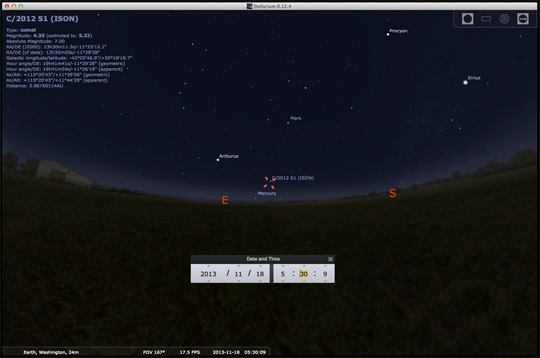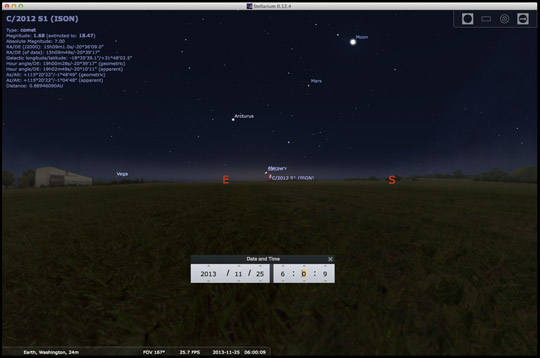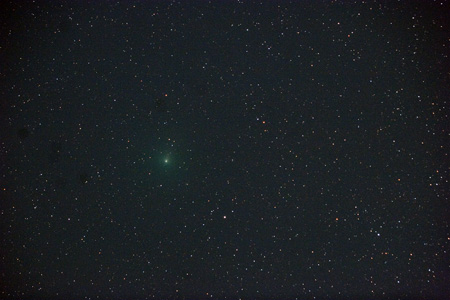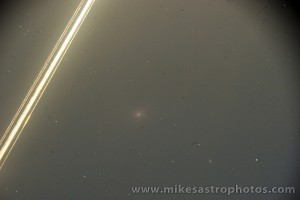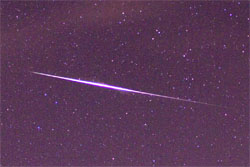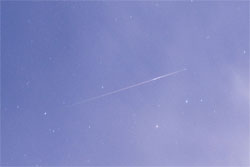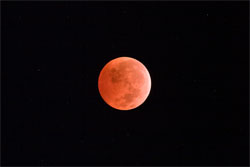Tag: Comet
Looking for ISON in November 2013
by Mike Hankey, under Comets & Meteors
Due to clouds and high humidity I have not been able to observe Comet ISON the last two days. The window of opportunity to catch ISON in darkness from my California observatory, while the comet is still above the 15 degree viewing threshold, is almost over. I might have 1 or 2 days left at best. Moving forward my efforts will be focused on DSLR photography of comet ISON. For the next week or so of November, ISON will be visible right before dawn on the horizon in the south east. We will then have to take a break while the comet goes around the sun. At this point the comet will only be viewable by NASA and ESA space based telescopes, but don’t worry several of them will be pointed at ISON while it grazes the sun. At some point in December, if the comet survives passage around the sun, we will start to be able to see it again in the western sky at and after dusk. If this happens it will be a spectacular sight potentially stretching across half of the sky.
Here is some information to help you observe comet ISON in November and December 2013. These ISON sky charts were created using the program Stellarium. Stellarium is a free planetarium software program that you can use to model the sky and solar system at your location. You will have to follow some special instructions to get comet ISON to show up in Stellarium. For power users, I have posted this information below.
Where is Comet ISON in November 2013 and what time will Comet ISON be visible in November 2013?
Most people interested in Comet ISON want to know where it is, what time it will be there, if they will be able to see it with their naked eye and what it will look like. Over the next week these ISON sky charts will help you find the comet while it is still visible in November.
This (Nov 18-Nov 25) is the last week to watch ISON before it passes the Sun! these ISON sky charts will help you over the next 6 weeks. To find it look in the East at 5:30 AM.
On Monday, November 18th, 2013 the comet will be visible low in the eastern sky by 5:30 am. The best viewing time for comet ISON this week will be between 5:30 – 6:00 AM. Here is a sky chart with Comet ISON for reference.
By the following Monday, November 25th, 2013, we will no longer be able to see ISON because it will be rising with the Sun. At this point we will have to eagerly wait to see what happens. I am thankful NASA has space telescopes that will watch ISON as it orbits the Sun.
How to show Comet ISON inside Stellarium?
The best way to plan out your Comet ISON observing session is the the planetarium program Stellarium. Once you download and install it, to add Comet ISON, follow these instructions:
- Press the ‘Configuration Window’ button on the left
- Press ‘Plugins’ Tab
- Press ‘Solar System Editor’
- Press ‘Configure’ Button
- Press ‘Import Orbital Elements in MPC Format’
- Press ‘Add Objects’ Button
- Select ‘Comets’ Radio Button, then ‘MPC’s list of observable comets’, then press ‘Get Orbital Elements’ Button.
- In the add objects search box enter ‘C/2012 S1 (ISON)’, select the check box and press the ‘Add Objects’ Button.
- Now you will be able to search for ISON, see where it is inside stellarium for your location, and change the viewing data and time.
This is certainly the BEST way to know how to find ISON in the sky. Good luck and happy observing!
Comet Hartley 2 – 103P/Hartley
by Mike Hankey, under Comets & Meteors
Comet Hartley 2 was as close as it gets to Earth last week. I snapped these pictures the night after the peak (as peak night was cloudy.)
Here’s an animated GIF of a sequence of images taken over a 45 minute time period. Clouds were coming and going so I had to drop some frames at the beginning of the animation. The line that goes through one of the frames is a satellite.
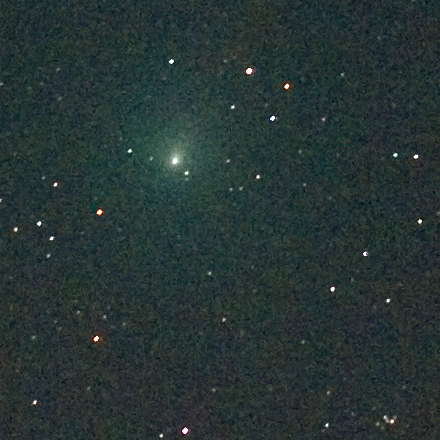
Comet Hartley 2 - Oct 22, 2010 16:26 - 17:17 UTC
The really really exciting thing about this comet is: NASA’s Jet Propulsion Laboratory is currently operating the EPOXI mission and one of the goals of this mission is to send a NASA probe (space ship) on a close fly by of this comet. This fly by is scheduled to take place in just a few days. You can read more about the EPOXI mission here.
Photo Details
William Optics FLT 98 / CGEM Mount
Canon 20Da Camera
No Auto Guider
30 second ISO 400 exposures
No stacking / no flat frame processing
minimal photoshop cleanup
UPDATE November 4th, 2010 From Gary Fujihara @ Big Kahuna Meteorites
For those of you who missed the live webcast, EPOXI spacecraft flew by Comet Hartley 2 a few minutes ago and took some absolutely stunning pictures with its Medium Resolution Imager. Here is a composite of 3 of the 5 closest approach images:
http://bigkahuna-meteorites.com/Images/CometHartley-04.jpg
And here is an Associated Press Story about the NASA mission.
